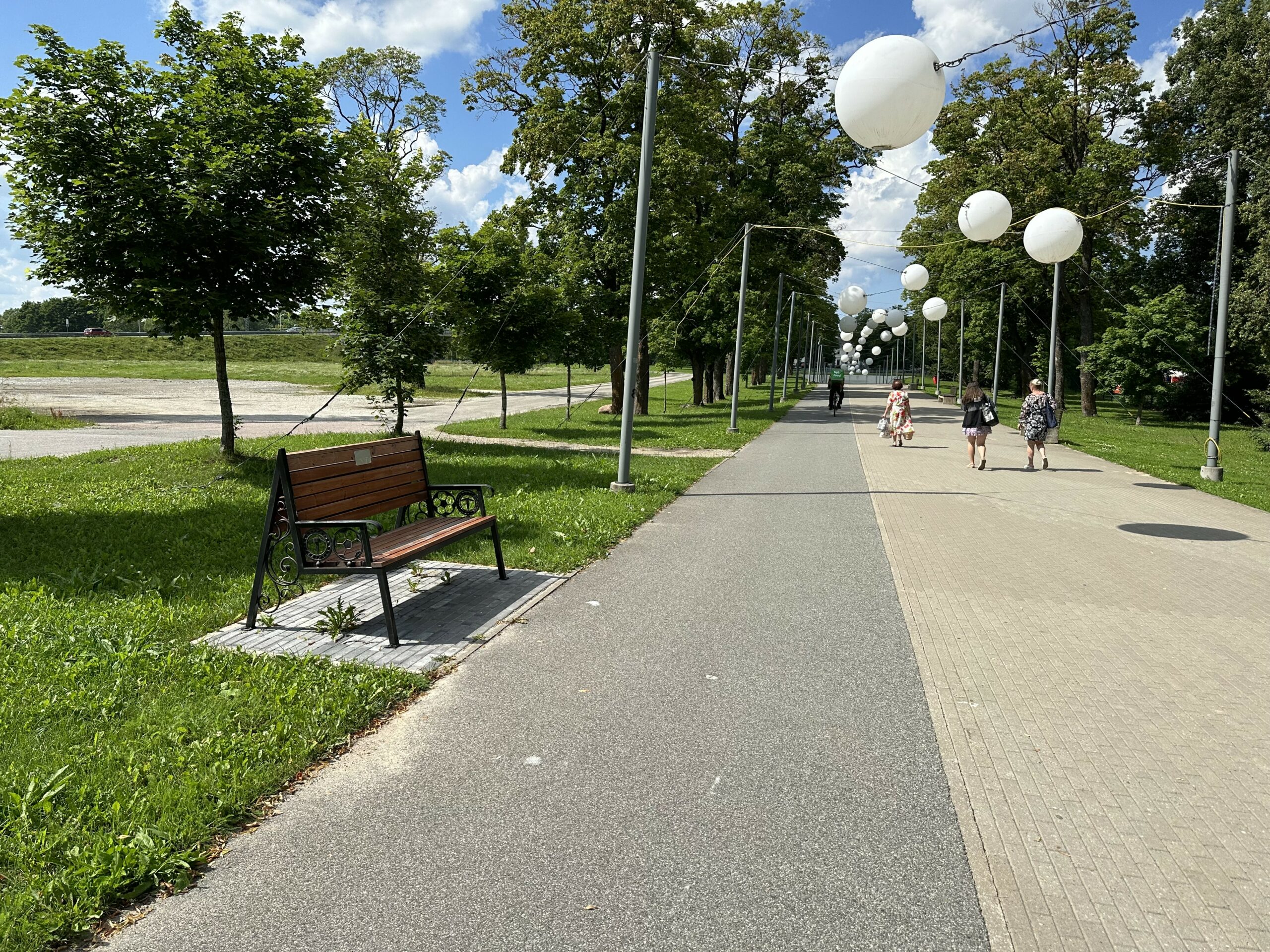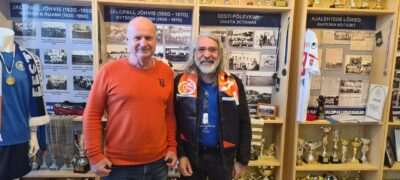A new commemorative bench will appear on the Jõhvi promenade. This time, the personalised art installation is dedicated to the “King of Oil Shale” and great sports enthusiast Väino Viilup. For now, this work by blacksmiths from Tallinn is located at the town stadium, near the spot where the well-known organiser and leader of the oil shale industry loved to watch football matches.
On 21 October, at the initiative of volunteers and leaders of the football club Phoenix, a display board and a commemorative bench were unveiled in honour of Väino Viilup, an Honorary Citizen of the parish. To mark the occasion, a ceremony was held at the Jõhvi People’s Football Museum, attended by Väino Viilup’s widow and children, as well as representatives of the parish council and administration.
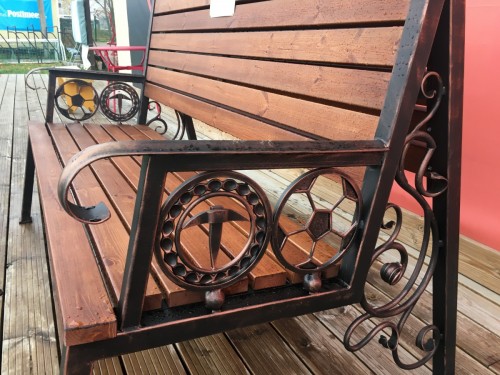
The photographs for the display board were kindly provided by Reet Viilup. These images reflect her husband’s sporting passions at various stages of his life. The museum also received a football bearing the name of the former head of “Eestishale”, and his children signed their names above the photographs of their father.
At the Jõhvi football stadium, following a brief speech by the chairman of the parish council, Vallo Reimaa, guests were entrusted with the honourable task of attaching a commemorative plaque to the bench installed for the occasion. The skilled work, crafted by the masters of the Aes Triplex blacksmith’s workshop in the capital, was created based on sketches provided by the Viilup family. The metal armrests of the art piece feature a forged football and a miner’s pickaxe — symbols closely tied to the legacy of the oil shale industry legend of Ida-Viru County. As Reet Viilup noted, her husband always made an effort not to miss his favourite team’s matches.
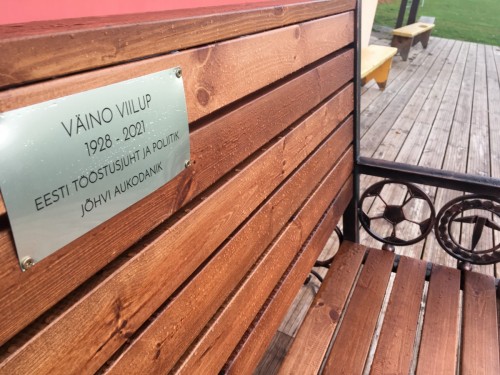
“My husband and I were brought even closer together by our shared love of sport. Not only did we attend home games, but we also travelled all over Estonia. I used to get very emotional watching our team play, and I knew all the footballers personally. It was lovely to see some old familiar faces — athletes — and to reminisce about those times. I especially loved watching the goalkeeper, because that’s where all the most exciting moments happened, particularly the penalty kicks. I remember a match against the ‘Norma’ team, when their coach kept shouting: ‘Watch that blond guy, he’s excellent with headers.’ That blond player is Sergei Sharymov, and he came here today, which really delighted me,” said Reet Viilup.
She expressed her gratitude to the Phoenix football club for ensuring that the memorial bench was completed in time for her husband’s birthday — a date the family had celebrated the day before.

Sergei Sharymov, a veteran of Estonian football and a player for the Estonia mine team, came here from distant Uzbekistan with his wife and children. At the time, Väino Viilup helped the young footballer settle into his new life.
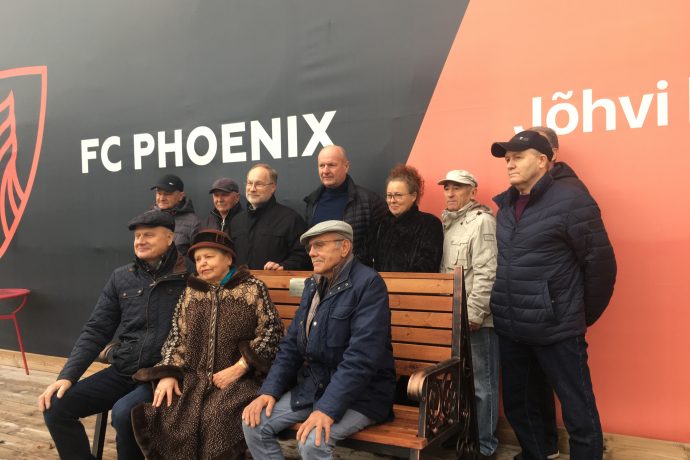
“Väino Viilup was a very dedicated supporter — not like today’s ultras, of course, but we lads always felt his backing. And we certainly remember the talking-to we’d get the next day if we lost. I arrived in Estonia as a seasoned footballer with solid experience, and in my very first game after moving, I scored a goal with a header. That’s when the kind of fame Reet mentioned really began. To be honest, there still isn’t a team that has won the Estonian Cup three years in a row — but we did back then. And that’s largely thanks to Mr Viilup, who put a great deal of effort into developing the Estonia mine team,” said Sergei Sharymov.

When Väino Viilup became director of the Estonia mine in 1972, he made an enormous contribution to the development of football in Ida-Viru County. Many athletes say without exaggeration that those were the golden years of the region’s favourite sport. A man of great ambition, the new director channelled all his boundless energy into building a strong football team. From being a regular underdog in the top league, frequently relegated to the second division, the team became a formidable opponent, winning every type of medal in the Estonian championship.
At that time, true professional miner-footballers emerged — players who were exempt from mine work from spring to autumn. They were only required to report for work in one case: if they lost. This form of punishment was imposed for poor performance on the field.
The head of the Phoenix football club, Sergei Ivanov, noted that installing a commemorative bench in honour of Väino Viilup is the least that can be done today for an Honorary Citizen who played a significant role in the development of north-eastern Estonia.
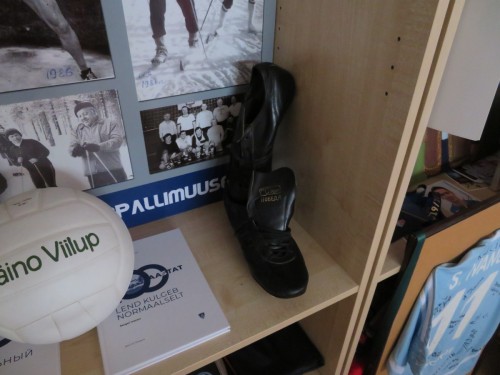
“It all comes down to memory: without it, there is no past, no present, and no future. The children playing on this pitch today have no idea how old this stadium is or how many generations have been able to enjoy their favourite sport thanks to this man. If a nation engages in physical activity and sport, that nation will thrive — and Väino Viilup proved this through his example and his dedication to grassroots sport. In the photographs, we see him at sixty years old shot putting, skiing marathons, playing volleyball, and taking part in basketball. Even at a very advanced age, he and his wife would take walks along the Jõhvi promenade, and he would come to open our matches here, at the stadium.”
The idea of installing a commemorative bench emerged this summer, during active discussions about the construction of an indoor football hall in Jõhvi, while the club was raising funds to bring the project to life. According to Phoenix volunteer Vladislav Naumov, it was at that time that forged football boots were added to the “100 Years of Football” monument, once again reminding everyone that football has a presence in the parish. There was also a desire to install another art object dedicated to this team sport. Upon seeing a report about a commemorative bench being unveiled for a prominent figure somewhere else in Estonia, the activist thought that the same idea could be realised here as well.
“This summer, Reet Viilup visited our museum, and the decision about whom to dedicate the new piece to came immediately. We shared our plans with parish representatives, received their approval, and began bringing the project to life. Unfortunately, the administration didn’t manage to prepare the site in time for the unveiling, so the bench is currently located at the stadium, near the spot where Väino Viilup loved to watch the miners’ team play,” the activist explained.
The entire financial burden for creating the commemorative symbol was taken on by the Phoenix club, while the installation is being handled by the parish. The bench won’t be moving far from its current location — in a few weeks, it will be placed near the old entrance to the stadium, where a small area is being specially prepared for it.
Denis Ozerov
Photo by the author
Reference:
Speaking of Väino Viilup’s biography, it is worth noting that he received his education not only at the Tallinn Polytechnic Institute but also at the Moscow Mining Academy. He began his career in Ida-Viru County in 1954 at the Tammiku mine. From 1958 to 1961, he served as Deputy Head of the Board of Oil Shale and Chemical Industry under the Republican Council of National Economy. He headed the Eestishale trust, the Estonia mine, was part of the leadership of the capital construction board, and served as both Director General and a board member of Eestishale.
From 1968 to 1971, Viilup was a deputy of the Supreme Soviet of the Estonian SSR, chaired the Kohtla-Järve city council for several years, and also worked as Deputy Chairman of the Jõhvi city council. In 2002, Väino Viilup was awarded the title of Honorary Citizen of Jõhvi, and in 2004 he received the Order of the White Star, Class IV. Viilup’s name is well known in sports circles — he chaired the Basketball Federation, the Eestishale football club, and the Kohtla-Järve Veterans’ Sports Council. Väino Viilup is an honorary member of the Kalev sports society.


